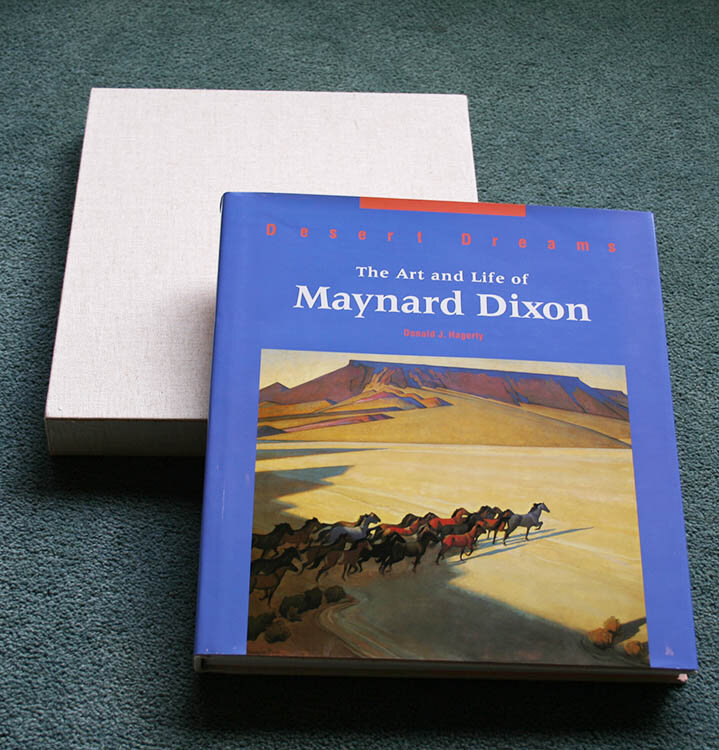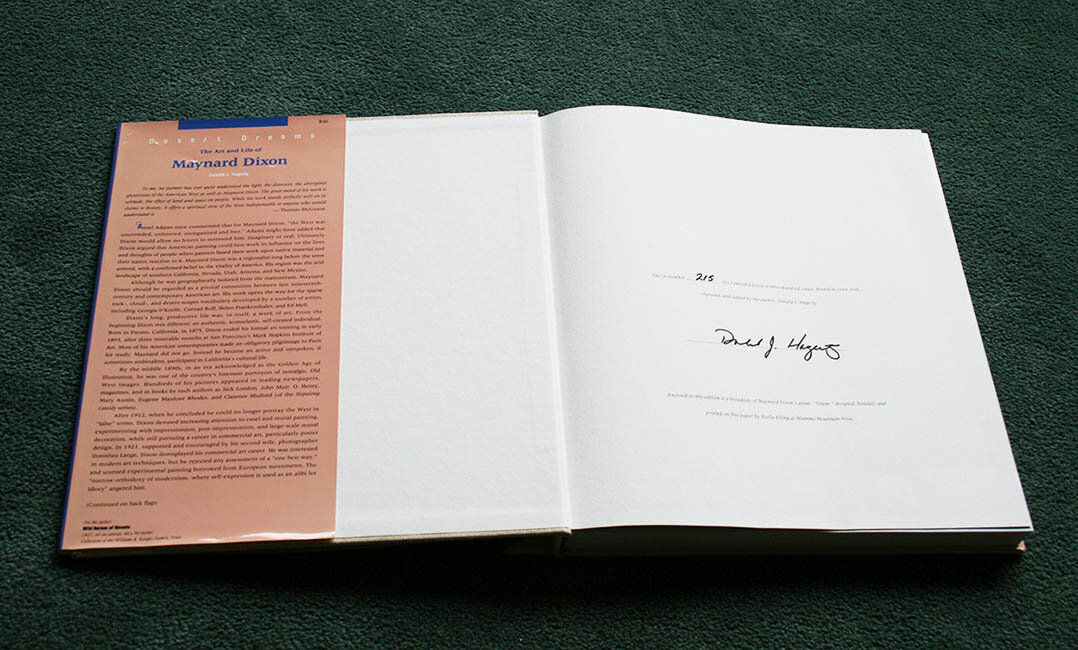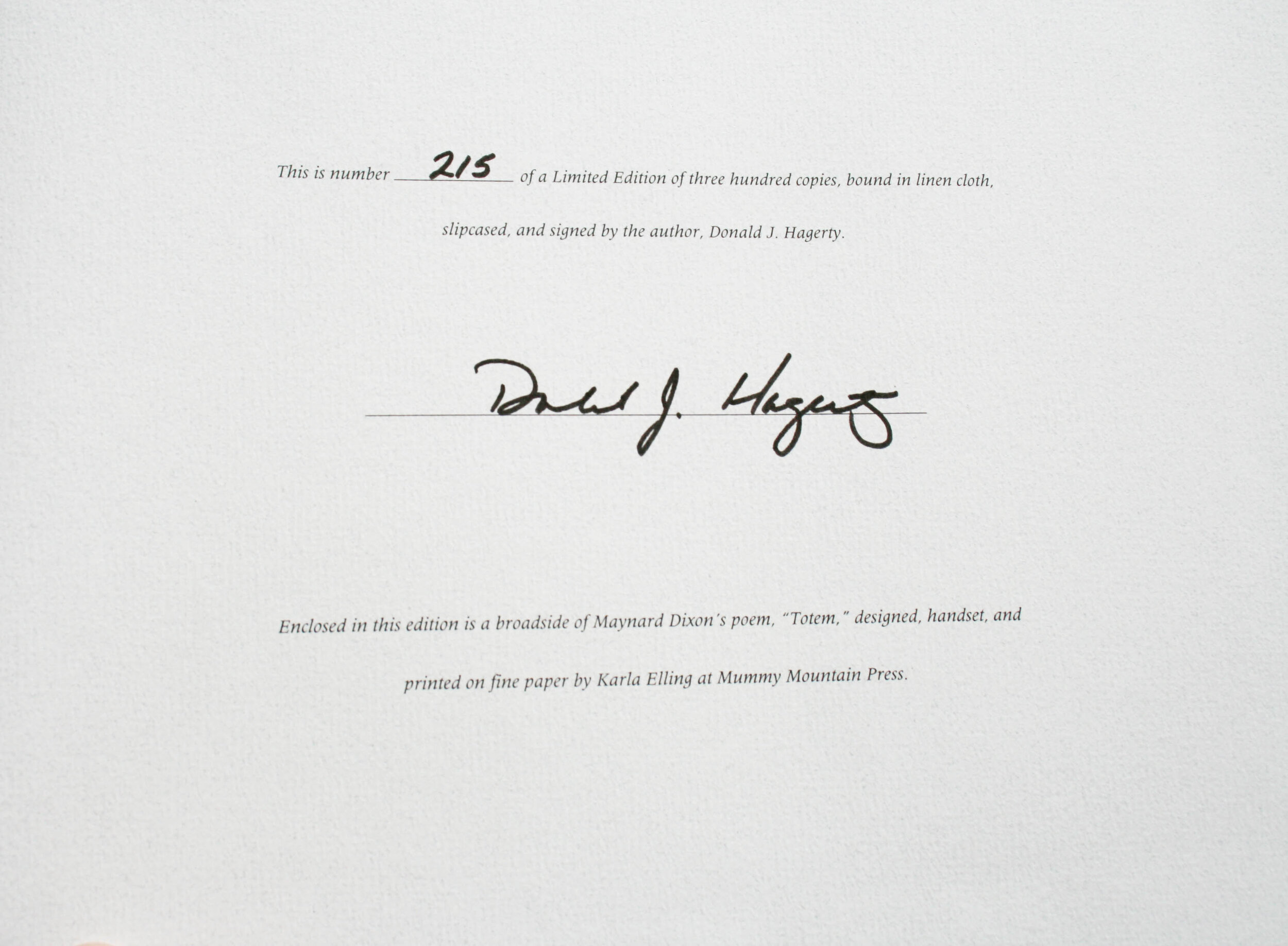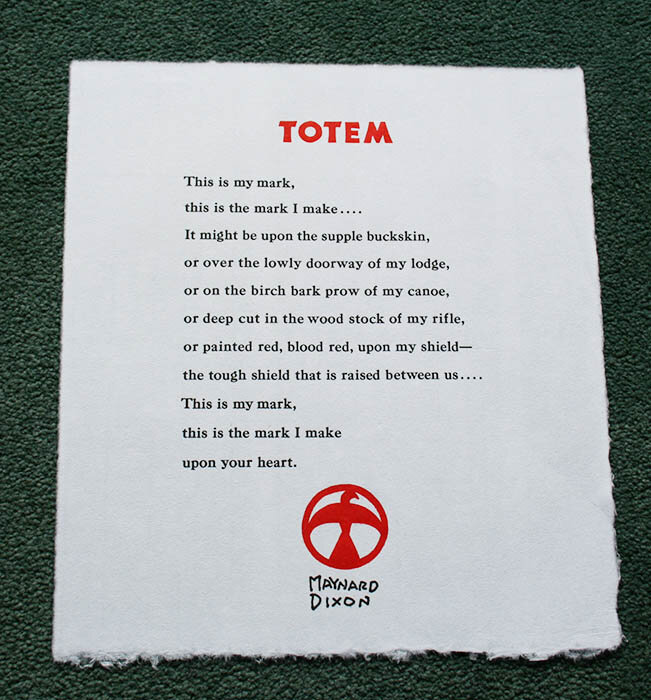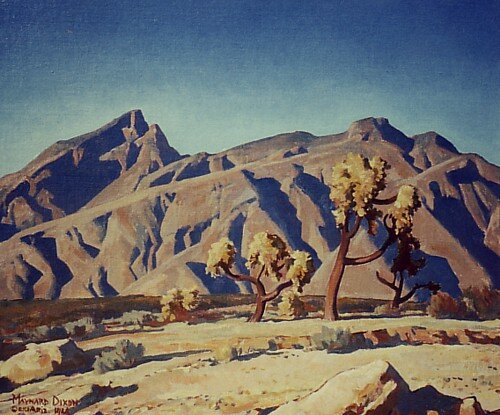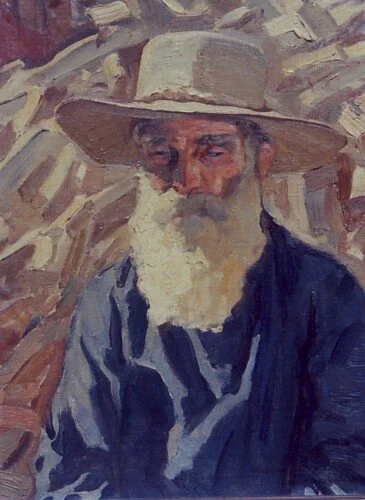Are you interested in selling or consigning your artwork?
Contact us now for a free opinion of value
Currently Available Artworks
MAYNARD DIXON
Maynard Dixon is best remembered and internationally known for his western landscape paintings featuring cowboys and indians, especially his desert and mountain scenes, and the WPA era murals he created in the 1930's. In the later years of his career Dixon's works were formed with bold masses of colors and simple lines and he is considered to be one of the first of the early modernist painters.
He was born on a ranch near Fresno, California, in 1875. A sickly child who was unable to participate in many physical activities, Dixon spent much of his time sketching scenes near the family home and was intrigued by stories he heard about the Old West. In 1893 the Dixon family moved to the San Francisco area, where Dixon tried studying at the Mark Hopkins Institute. Finding formal study unpalatable, he quickly left the school for work as an illustrator, a job which earned him respect and acclaim.
Starting in 1895 he earned a living as an illustrator for local newspapers including the San Francisco Morning Call and later, the Examiner. In 1899 he began to take trips to the Southwest, especially to Arizona, to paint and sketch the area that continued to fascinate him throughout his lifetime. Some of his most famous works featured the Navajo Indians at Canyon de Chelly. During this period he was also showing his work at the San Francisco Art Association.
In 1905 he married artist Lillian West Tobey, just prior to the 1906 San Francisco earthquake which destroyed most of the early paintings in his studio. He and his wife moved to Sausalito, on the other side of the San Francisco Bay, where they lived until 1907. He then began work on a commission from the Southern Pacific Railroad where he painted a mural for the train depot in Tucson, Arizona.
Next, he traveled to New York City to work as a magazine illustrator and became a member of both the Salmagundi Club and the prestigious National Academy of Design. In 1909 he left for Idaho and Montana where he worked on a Cattle Ranch and experienced firsthand the daily life of the rugged cowboys and wranglers, making sketches of them and the surrounding majestic landscape. Dixon finally returned to California in 1912 and began to focus on his own paintings. In the years that followed he suffered a nervous breakdown during the 1915 Pan Pacific International Exposition and he divorced his wife.
During the summer of 1931 he exhibited with the most prominent artists of the West, including William Ritschel, Armin Hansen, Granville Redmond, and Leland Curtis, at the Tahoe Tavern on Lake Tahoe.
His second marriage, in 1920 to photographer Dorothea Lange, ended in 1935. He then married artist Edith Hamilton in 1937 and, due to his health issues, particularly his struggles with asthma, they spent most of their time in the drier climate of Tucson. However, he also established a home and art studio in Mount Carmel, Utah in 1939. This property is now the location of the Thunderbird Foundation for the Arts, home of the Maynard Dixon Living History Museum. He often signed his paintings with an Indian Thunderbird Logo. Dixon eventually died in Tucson, Arizona in November of 1946.
His works have been exhibited at numerous important galleries and museums including the Stendahl Gallery and Biltmore Salon in Los Angeles, the Pasadena Art Museum and The De Young Museum.
His murals can be found in many venues, including the main reading room of the Sacramento State Library, the Martinez Post Office, John C. Fremont High School, the Biltmore Hotel in Phoenix, and the Mark Hopkins Hotel's Hall of the Dons.
For additional information, visit:
Wikipedia
Thunderbird Foundation for the Art/Maynard Dixon Living History Museum
Public Art and Architecture/Dixon Mural at the California State Library, Sacramento
Maynard and Edith Hamlin Dixon House and Studio
Brigham Young University Collection Highlights
Wild Horses of Nevada, 1927
Oil on canvas
44 x 50 inches
NOT FOR SALE
This important painting has been prominently featured in numerous Museum exhibitions over the years, and was used as the cover image for the essential book, “Desert Dreams – The Art and Life of Maynard Dixon”. This comprehensive publication was written by Donald J. Hagerty and is the product of 15 years of intensive research. The painting is owned by the William A. Karges Family Trust and is not for sale at this time.
“Wild Horses of Nevada” was painted in 1927, during a period when DIxon experimented with the concept of non-objective art and began exploring ideas and techniques related to the more progressive art movement now referred to as “Modernism”. He was aware of European art styles including Cubism, Futurism and Surrealism and his western landscapes began to incorporate broad, clean areas of color, sharp definition of edges, subtle gradations of hues, and the use of nearly monochromatic earth tones. This painting is an excellent example of his increasingly simplified, two-dimensional compositions that included cubist-realist influences.
It is likely that this painting was one of fifty-six works painted during a very productive time in Dixon's career, during a four month trip through Nevada that began in October 1927.
As noted by Donald Hagerty in Desert Dreams; “In this large painting, Maynard applied cubist-realist principles to the desert's reality, a scaffold for the angular forms. The painting's unusual angle of vision, a bird's-eye perspective, shows a group of wild horses thundering across an alkaline flat. He composed the canvas with a thoughtful and bold use of pattern, expressive but modest distortion of form, a clean surface unencumbered with unnecessary detail, and a limited color scope massed in large areas”.
“Wild Horses of Nevada” has been included in a large and diverse group of noteworthy exhibitions in respected Museums across the United States. Below is a partial list of prominent institutions that have coordinated these shows with themes ranging from the American West to the Role of Horses in the History of the country.
Museum Exhibitions
1993 - Included in a traveling exhibition organized by Museum of Fine Arts, Museum of New Mexico in conjunction with the release of the Book “Desert Dreams – The Art and Life of Maynard Dixon”.
1994 - “Desert Dreams: The Art of Maynard Dixon” at the Gene Autry Western Heritage Museum in Griffith Park.
2007 - "Dixon's West", Pasadena Museum of California Art featured 106 of Maynard Dixon's paintings and drawings.
2007 - 2008 - Figge Art Museum "Go West!", Davenport, Iowa
2010 The Art Museum at the University of Kentucky staged an exhibition on the horse in American Art that coincided with the World Equestrian Games that year.
The museum noted that “Horses have played a crucial role in building the United States. They have carried generals into battle, forged the trail of westward expansion, hustled for cowboys, and sprinted under jockeys for cheering fans. As such, horses became a meaningful part of American cultural identity symbolizing heroism, wildness, hard work, and prosperity," The exhibition, entitled Hoofbeats and Heartbeats, was the first significant exhibition to critically examine the role of the horse in American art, history and culture.
2012 - Figge Art Museum, Davenport, Iowa "The American West as Myth: Art from the Figge and Private Collections"
2013 National Museum of Wildlife Art, Jackson Hole, Wyoming
2014 Crocker Museum of Art, Sacramento, California
2015 Annual “Maynard Dixon Country” art gathering at the famed artist’s historic home and studio in Mt. Carmel, Utah
2016 Nevada Museum of Art
2019-2020 "Maynard Dixon's American West" at the Scottsdale Museum of the West, described as "the most comprehensive retrospective ever showcasing Maynard Dixon’s life and artistic career." More information about this exhibit can be found here.
2020-2021 "Borein and Friends" at the Santa Barbara Historical Society
2021 Autry Museum of the American West, Los Angeles, California
“Desert Dreams – The Art and Life of Maynard Dixon”, Limited Edition book available now, call (800) 833-9185 for information and price.


